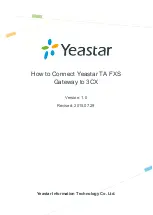
Chapter 1 Overview
Understanding How the VG248 Supports Telephony Features
1-4
Cisco VG248 Analog Phone Gateway Software Configuration Guide
OL-1209-02
Understanding Voice-Mail Message Indicators
The VG248 can receive message-waiting indicator (MWI) information from
Cisco CallManager and send it to analog phones. The VG248 sends MWI
messages using any of the following methods:
•
Playing stutter dial tone when a user picks up the phone
•
Illuminating the MWI lamp on the phone
•
Using caller ID mechanism to send information to the LCD screen on the
phone
You can enable or disable any of these options. See the
“Choosing Message
Waiting Indicator Type” section on page 3-11
for details.
Understanding Call Control Modes
The VG248 supports different call control modes, which indicate how users
access and use the supported telephony features. You can choose the call control
mode appropriate to the specific needs of your users and the abilities of your
analog devices. The supported call control modes include:
•
Basic
•
Standard
•
Feature
To understand the differences among the three modes, keep in mind the following
tips:
•
The three modes differ in how they support transfer and conference.
•
All modes support call waiting, and you can disable it on a per port basis
using Cisco CallManager.
•
All modes support feature codes for speed dial, redial, call forward and
pickup, and you can define or disable them on a per device basis.
•
Users can access features using the hook flash, 0-9, *, or # buttons, depending
on how you have configured the feature codes.
•
You cannot use a double flash hook.
See the
“Choosing the Call Control Mode” section on page 3-4
for details about
setting the call control mode on the VG248.
















































